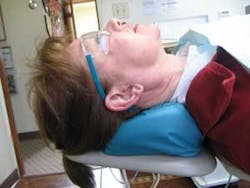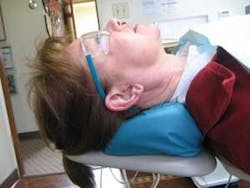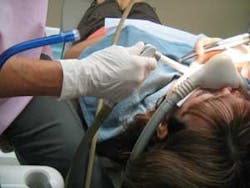Ten low–cost strategies to "ergonomize" your operatory
by Bethany Valachi, MS, PT, CEAS
For more on this topic, go to www.dentaleconomics.com and search using the following key words: ergonomics, Bethany Valachi, contoured headrest, tilting seat, neutral operating posture, rubber dam, pain–free suction.
What's the first thing that comes to most dentists' minds when updating or making changes to their offices? Cost. Upgrades in dental offices typically require a substantial monetary investment. When we think of ergonomic improvements, expensive patient chairs, loupes, stools, and delivery systems come to mind. But hold onto your pocketbooks — here are 10 easy ergonomic improvements you can make in your operatory to improve health, prevent pain, work more comfortably, and increase productivity — with minimal (or no) expense!
1 Chin up. Getting the patient into a fully supine position with the chin raised can be challenge. This is especially important when treating the upper arch. Double articulating headrests easily angle up into the occiput to raise the chin for better viewing; however, chairs with flat headrests may pose a positioning problem. A dental headrest cushion contoured to support the cervical curve, without pushing the head forward, helps position the patient for better viewing (see Fig. 1).Patient feedback on the comfort of these memory headrests is usually very favorable. Crescent Products also makes a larger Osteo Pillow for geriatric patients whose kyphotic head posture can be a challenge to support. Caution: some "dog bone"–shaped headrests are too large for the patient's cervical curve and actually push the head and chin forward and down. This is the opposite of what you want for viewing the upper arch. ($54.95 — Crescent Products, www.crescentproducts.com/dental.htm)
2 Go for the tilt. The benefits of a tilting seat on your operator stool are numerous (see Feb. 2008 Dental Economics®: "Why Let Plaque be a Pain in the Back?"). A flat seat causes your pelvis to roll backward, which flattens your lumbar spine and predisposes it to injury. Sitting with your thighs sloping slightly downward places the pelvis in a more neutral position and helps you maintain your lumbar curve with less muscular effort. You can retrofit your (or your hygienist's) non–tilting operator stool with an ergonomic wedge cushion to gain the ergonomic benefits of a tilting seat pan for a fraction of the cost of a new stool. Sitting on the air–filled cushion helps strengthen core–stabilizing muscles, which is a key to pain prevention. ($34.95, FitBall® Wedge Cushion, www.posturedontics.com)3 Move it. The 12 o'clock position offers dentists the most neutral operating posture. It reduces the need to elevate the arms and shoulders, and allows close proximity to the patient without obstruction by the patient chair. If the 12 o'clock position is not easy to obtain in your operatory, try swiveling your patient chair about 20 degrees. Sometimes this places the assistant closer to a fixed counter so he or she can retrieve items more easily. If your patient chair is too close to a fixed counter, consider moving the patient chair six to 12 inches toward the foot of the chair. Be sure to consult with your dental supplier before you move the chair, as the location of the electrical box can be a limiting factor. Make sure you have several strong bodies to help with the effort, and use proper body mechanics. (No cost!)4 Close proximity. See if your patient chair can be retrofitted with a narrower backrest to allow closer operator positioning in the 8 o'clock to 11 o'clock positions. For example, the A–dec Cascade patient chair may be retrofitted with the narrower A–dec Pedo backrest to gain approximately three inches closer proximity to the oral cavity. Keep in mind that narrower backrests may not adequately support very large patients. ($550 to $800 — A–dec Pedo Backrest. Contact your local dental supplier.)5 Dam it. Using the rubber dam can decrease neck and shoulder strain by reducing the need for the assistant or dentist to manually retract slippery cheek tissue. It allows dentists to better use indirect vision, and eliminates the need to constantly struggle against soaked cotton rolls and flopping tongues. ($300+ — complete rubber dam kit)6 Swap cylinders. Operator stools that are too tall or too short can wreak havoc on spinal health. If at the lowest adjustment you cannot sit all your back on the seat, but are forced to perch on the edge of the seat, you should order a shorter cylinder from the manufacturer. On the other hand, if at the highest adjustment your thighs are still parallel to the floor and not sloping slightly downward, you should request a taller cylinder. (Most manufacturers swap these out at no cost if the stool is still fairly new.)7 Pain–free suction. Chronic hand and wrist pain is common among assistants. Awkward wrist and hand postures while suctioning can exacerbate this condition. The ErgoVac is a new, ergonomic, HVE handpiece that places the tip at a 110–degree angle to the handpiece (see Fig. 2). This allows for more neutral hand/wrist posture and reduces fatigue when suctioning. An optional swivel adapter is also available. ($76–$84, Hager Worldwide, www.hagerworldwide.com)In dental ergonomic consultations, I look for the least expensive solutions first. As you begin your transition to an ergonomically sound practice, be sure to look for ergonomic education and products that are research–based, and for product reviews that are unbiased. This is important not only to prevent wasting money, but also to safeguard your health. You've invested a great amount of time and money into your professional career. Small investments in your health can lead to a longer, healthier career!
Bethany Valachi, PT, MS, CEAS, is a physical therapist, dental ergonomic consultant, and CEO of Posturedontics, a company that provides research–based dental ergonimic education. A clinical instructor of ergonomics at OHSU School of Dentistry in Portland, Ore., she is a member of the National Speakers Association. Valachi lectures internationally at dental meetings, schools, associations, and study clubs. She covers these subjects and more in her new book, "Practice Dentistry Pain Free: Evidence–Based Strategies to Prevent Pain and Extend Your Career." Contact Valachi at www.posturedontics.com or by calling (503) 291–5121. Send your comments to her at [email protected].


